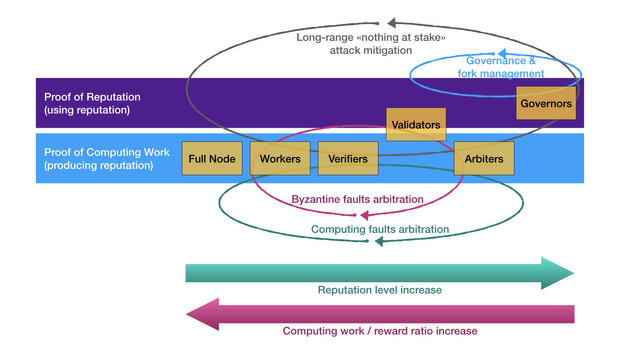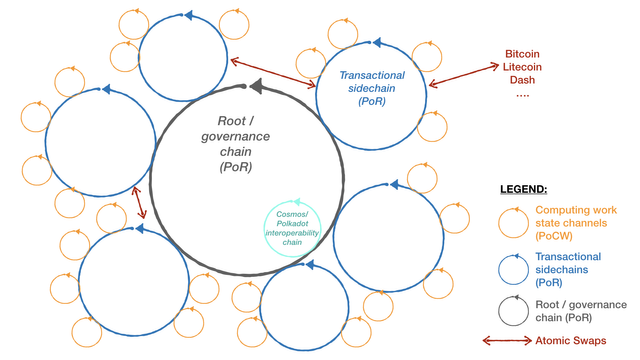Introducing PROMETHEUS: a highly-scalable two-tier hybrid consensus

PROMETHEUS is a next-generation consensus protocol for public blockchains that utilizes two-tier hybrid consensus model allowing highly-scalable distributed censorship-resistant computing.

PROMETHEUS Design: node types, consensus tiers, arbitrations / conflict resolution
The first tier of the consensus is based on Proof of Reputation (PoR) — a variant of PoS consensus where stake of verifier nodes is composed of both monetary resource (cryptocurrency) and reputation (which can’t be transferred or bought). Reputation is earned on the second tier of consensus — Proof of Computing Work (PoCW), where nodes performing different types of parallel computing tasks (like running neural network computation or other parallelizable computing jobs) get paid (mine) and acquire reputation by proving correctness of the computation results. PoCW tier has provable Nash equilibrium and provides a better alternative to other PoW models.Overall network security and most of its advancements emerges from combination of both tiers. This intrinsically solves the main problems of existing consensuses:
- waste of energy on unnecessary work in PoW models
- low security and low trustless quality in earlier PoW attempts (like calculating protein folding tasks etc)
- long-range attacks on PoS consensuses
- mining centralization in PoW
- inflation in PoS models that can lead to stake oligopolization
- scalability of public blockchains
Prometheus was designed according to the following six criteria in mind:
- scalability first: we use three-level sidechains in order to achieve unprecedented network scalability

PROMETHEUS scalability and interoperability design
- censorship resistance: the network resists N-1 byzantine faulty block verifiers at the first tier of consensus and N (all) byzantine faulty block verifiers at the second
- sustainable decentralization: the system does not tend to centralize with time in both wealth, reputation or computing (mining) power distribution
- formal verification with game theory models (Nash and other types of equilibrium); byzantine fault tolerance level and nonlinear dynamics (analysis of phase space in time for all possible consensus outcomes)
- governance and extensibility: consensus has embedded model for protocol governance and extensibility with new forms of supported computing. Governance model is designed in such a way that allows to avoid hard forks of the upgraded version due to protocol changes (but fork mechanism is preserved for active minority that would not like to follow the new consensus).
Over the next few weeks we will be revealing more details and papers on PROMETHEUS consensus. It will also be used in forthcoming Pandora Boxchain releases: while current version runs on top of Ethereum, full strength of censorship-resistant cognitive computing requires stronger (in terms of security, scalability and censorship resistance) consensus level and PROMETHEUS is designed to fit these goals.